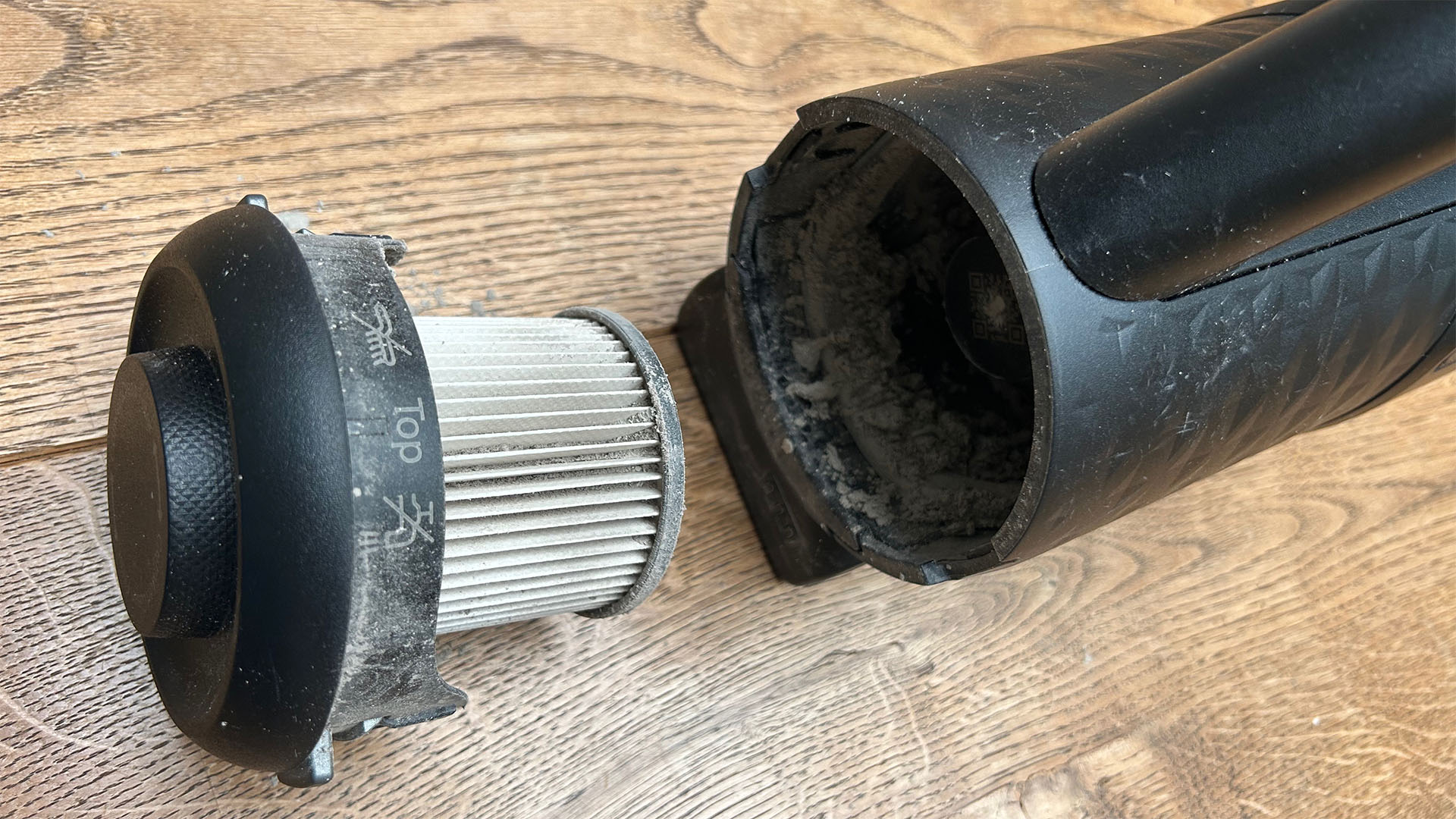Why is my vacuum cleaner not vacuuming?

Let's face it, vacuuming is not a job that most of us look forward to, even if you've treated yourself to one of the best vacuum cleaners with all the bells and whistles. Sure, it's better than getting down on your hands and knees with a brush, but it's hardly anyone's idea of fun.
So few things are more frustrating than when you've psyched yourself up to do it, only to find that your vacuum cleaner isn't picking up any dirt or debris. You keep pushing it back and forth, but nothing gets sucked up. Maddening, right?
But if this has happened to you, don't worry: you probably won't need to spend a lot of money buying a brand-new vacuum cleaner. There are a series of simple troubleshooting steps that will in all likelihood get it working properly again. Here are seven potential solutions to a vacuum cleaner not vacuuming, along with some good habits that can prevent problems occurring in the first place.
1. Check the bag
Most vacuum cleaners suck the dirt into a bag, and that eventually needs emptying, otherwise the vacuum cleaner will stop working properly. Those that don't have bags just have an internal canister that does the same job, so that will need emptying too.
It's best not to wait until that stage, though. To keep your vacuum cleaner exerting maximum suction, you should make it a habit to empty its bag or canister on a regular basis, which will typically be once a week. At the same time, clean out the area around the bag or canister to prevent debris and dirt building up around there.

Finally, keep checking that the bag itself is in good shape, because eventually they will tear, degrade or otherwise break and that will stop the vacuum cleaner working properly too. So make sure you replace the bag before it gets to that stage and you'll be less likely to run into problems.
2. Check the settings
Here's another issue that's relatively easy to fix. Some vacuum cleaners have adjustable settings, which set the brush roll height for specific terrain such as thick carpet, thin carpet or wooden floors. And so if they're on the wrong setting, your vaccum cleaner may not function properly. For instance, a wooden floor setting will push it too far into plush carpet, creating excessive drag on the brush roll. So always follow the vacuum's instructions carefully.
Sign up for breaking news, reviews, opinion, top tech deals, and more.
3. Check for clogs
Aside from the bag filling up, the most common reason for a vacuum cleaner not working properly is a clog somewhere inside the mechanism. Because we'll be honest: no vacuum cleaner is perfect, and over time debris such as dirt, pet hair, human hair and other debris is going to get trapped in the hose, the base, the canister or elsewhere in the machine. And these blockages can make a real difference to the amount of suction you get.
To check for clogs, unplug your vacuum cleaner and remove the hose (depending on the design, this may involve use of a screwdriver). Use a long stick, such as a broom handle, to dislodge any clogs that are stuck in the hose or its attachment to the body of the vacuum. Finally, check inside the canister or base unit itself for clogs.
4. Check the filters
Modern vacuum cleaners rely on filters to minimize clogging. However, over time the filters themselves will also get so clogged up that air can't make it through. So again, you need to check the filters regularly.
Some filters are washable, so you can rinse them with tap water until they are clear of debris. Otherwise, you'll need to replace them with new ones.
Not all vacuum cleaner filters are the same, so it's important to use the right one for your machine. Using the wrong filter could impact performance and allow more dust and allergens to pass back into the air you brea.

Many vacuum cleaner brands sell proprietary filters that are specially engineered and treated with antimicrobial coatings to trap microscopic particles. Third-party manufacturers also make generic replacement filters that are compatible with popular vacuum cleaner models and more affordable.
When replacing a filter, be sure to closely follow the manufacturer's instructions to install it properly. An improperly installed filter can allow unfiltered air to bypass it entirely, reducing suction and allowing debris to re-circulate.
5. Clear the brush roll
If your vacuum cleaner has a rotating brush roll, it's inevitable that materials such as hair, clothing fibers or string will end up getting wound around the brush over time. This creates drag that prevents the brush from spinning properly, and this can make a big impact on your vacuum cleaner's ability to suck up dirt.
So after each use, unplug the vacuum cleaner and disconnect the hose and brush attachment. Use scissors to snip away any unwanted fibres wrapped around the brush. You can also use a seam ripper or even a sturdy pen or pencil to dislodge debris stuck in between the brush bristles.

While you have the brush roll out, take a closer look at the bearings on either end of the brush that allow it to spin. If these are worn down, the brush roll won't spin effectively, which reduces its vacuuming power. If the bearings look extremely worn, scored or frozen up, the entire brush roll probably needs to be replaced. This is a common issue with older vacuum cleaners that have seen a lot of use over the years.
To keep your vacuum's brush roll working at peak performance, make it a habit to regularly remove hair, strings and debris that gets tangled around it. This simple maintenance can go a long way in preventing clogs and preserving suction power.
At least once a month, remove the brush roll completely and soak it in a sink of hot water and dish soap to dissolve stuck-on gunk. An old toothbrush can help scrub away stubborn debris. Then rinse the brush roll thoroughly and allow it to fully air dry before re-installing it.
6. Check for cracks or holes
Another common issue is cracks or holes in the vacuum cleaner hose, base or body that allow air to escape. So if your vacuum doesn't seem to be sucking properly, carefully inspect all areas of the vacuum cleaner for splits, punctures or openings that could permit air leakage.
Small cracks or pinholes in vacuum cleaner hoses and attachments can usually be sealed up using a vacuum cleaner hose repair kit or heavy-duty duct tape. For larger damage, though, you'll likely need to replace the entire hose or attachment.
The vacuum's main body or canister is more complicated and expensive to replace. If the housing is cracked, you may need to weigh the cost of a repair or replacement against just buying a new vacuum, factoring in the age and condition of your current model.
To prevent future cracks, be careful not to knock or drop your vacuum cleaner. The plastic housings can become brittle over time, so handle the unit gently. And avoid pulling too hard on the hose when it's wedged under furniture.
7. Repair or replace your vacuum
If none of these tips solve your suction issue, then it's probably time to take your vacuum cleaner to a repair shop or look into purchasing a replacement.
For newer vacuum cleaners under warranty, it's usually worth taking advantage of the free repair service from the manufacturer or authorised repair center. Older out-of-warranty cleaners may make more sense to replace if the estimated repair costs approach 50 per cent or more of a new model's price.
Some repairs, such as replacing broken wheels, power cords or other components, can make an older vacuum cleaner last longer. But it may not be cost-effective to invest in major repairs for a vacuum cleaner over five years old.
When replacing your vacuum, look for models with high-efficiency particulate air (HEPA) filters, brush rolls designed to prevent hair wrapping, and generous cord lengths. The vacuum's weight, maneuverability and noise level are other factors to consider.
If you're looking for something portable, meanwhile, see our guide to the best cordless vacuum cleaner. Alternatively, if you want to absolutely minimize effort, consider investing in the best robot vacuum. Finally, make sure you dispose of your old vacuum cleaner properly without adding to landfill. Follow our guide to how to recycle a vacuum cleaner for more on that.

Tom May is a freelance writer and editor specialising in tech, design and sleep products. Over the years he's tested a number of mattresses, duvets and pillows, and as a back pain sufferer, has a keen interest in finding ones that offer maximum support. Plus, in running a successful Airbnb business, sleep hygiene and providing the right bedding for guests has become a big part of his day-to-day life. He is author of Great TED Talks: Creativity, published by Pavilion Books.